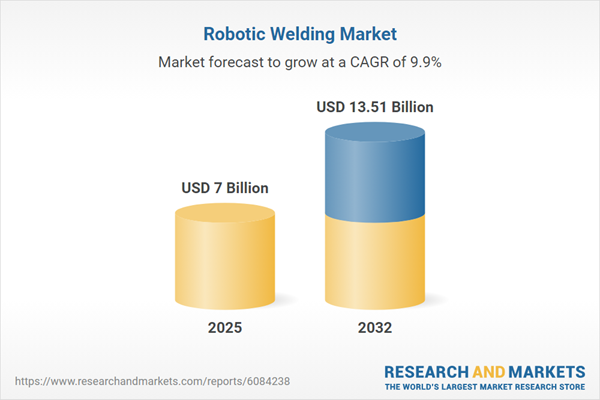Speak directly to the analyst to clarify any post sales queries you may have.
Robotic welding is transforming manufacturing, enabling companies to achieve new levels of efficiency, precision, and operational reliability. As a result, organizations across industrial sectors are integrating automated welding solutions to boost quality control and adapt to evolving production challenges.
Market Snapshot: Robotic Welding Market Growth and Outlook
The Robotic Welding Market grew from USD 6.37 billion in 2024 to USD 7.00 billion in 2025. It is expected to continue growing at a CAGR of 9.85%, reaching USD 13.51 billion by 2032.
Scope & Segmentation of the Robotic Welding Market
- Welding Processes: Includes arc welding (MAG, MIG, plasma, TIG), electron beam welding, friction stir welding, laser welding (CO2, disk, fiber, Nd:YAG), resistance welding (projection, seam, spot), and ultrasonic welding.
- Robot Types: Covers articulated robots, Cartesian robots, collaborative robots, delta robots, and SCARA robots suitable for a range of applications and payloads.
- End User Sectors: Identifies aerospace, automotive, construction, electronics, general fabrication, oil and gas, and shipbuilding as key markets driving adoption.
- Components: Encompasses hardware, software, and services including installation, maintenance, repair, and training.
- Integration Types: Differentiates between integrated systems and standalone system solutions.
- Payload Ranges: Addresses less than 10 kg, 10–50 kg, 50–100 kg, and above 100 kg to meet varying assembly needs.
- Regional Coverage: Highlights regions such as the Americas (North and Latin America), Europe, Middle East & Africa (EMEA), and Asia-Pacific, as well as key countries including the United States, China, Germany, Japan, and others.
- Leading Companies: FANUC, Yaskawa Electric, ABB, KUKA, Kawasaki Heavy Industries, Daihen, Nachi-Fujikoshi, Panasonic Holdings, Mitsubishi Electric, and Comau are among those shaping the competitive landscape.
Primary Keyword: Robotic Welding Market – Key Takeaways
- Advances in automation, AI integration, and real-time data feedback underpin robust performance and consistent weld quality across manufacturing environments.
- The expansion of collaborative robots allows small and medium enterprises to seamlessly integrate automation, optimizing safety and productivity without significant barriers.
- Emerging welding modalities such as friction stir and laser welding reduce heat input and distortion, supporting higher precision in diverse, value-focused applications.
- Unified software platforms for predictive maintenance and simulation play an essential role in enhancing system availability and reducing downtime.
- Industry leaders are shaping their technology roadmaps through alliances, modular platforms, and smart analytics, promoting continual innovation and service differentiation.
- Regional shifts reflect diverse adoption drivers, with countries prioritizing automation to balance labor costs, regulatory requirements, and supply chain resilience.
Tariff Impact on Supply Chains and Operational Costs
Recent United States tariffs on imported robotic welding equipment, components, and raw materials such as steel and aluminum have prompted manufacturers to review procurement strategies. Companies are mitigating increased costs by pursuing local partnerships, flexible contracts, and sourcing alternatives. These measures foster resilient and adaptable supply chains capable of adjusting to shifts in trade policy and material availability.
Methodology & Data Sources
This report employs a multi-stage research approach, combining primary interviews with industry experts, end-user surveys, and insights from trade associations. Data has been validated through triangulation and cross-referenced with technical publications, regulatory filings, and direct feedback from plant managers and integrators. Quantitative shipment and procurement trends further support the robustness of findings.
Why This Report Matters
- Receive actionable insights for strategic planning in automation, supply chain management, and new technology adoption within the robotic welding industry.
- Understand comprehensive segmentation, technical advances, and regional dynamics to guide investment decisions and long-term operational optimization.
Conclusion
Robotic welding continues to redefine the future of precision manufacturing. Organizations equipped with data-driven insights and proactive automation strategies will lead in operational agility and competitive performance. This report serves as a comprehensive resource for navigating the evolving industrial landscape.
Table of Contents
3. Executive Summary
4. Market Overview
7. Cumulative Impact of Artificial Intelligence 2025
Companies Mentioned
The companies profiled in this Robotic Welding market report include:- FANUC Corporation
- Yaskawa Electric Corporation
- ABB Ltd
- KUKA Aktiengesellschaft
- Kawasaki Heavy Industries, Ltd.
- Daihen Corporation
- Nachi-Fujikoshi Corp.
- Panasonic Holdings Corporation
- Mitsubishi Electric Corporation
- Comau S.p.A
Table Information
| Report Attribute | Details |
|---|---|
| No. of Pages | 187 |
| Published | November 2025 |
| Forecast Period | 2025 - 2032 |
| Estimated Market Value ( USD | $ 7 Billion |
| Forecasted Market Value ( USD | $ 13.51 Billion |
| Compound Annual Growth Rate | 9.8% |
| Regions Covered | Global |
| No. of Companies Mentioned | 11 |









